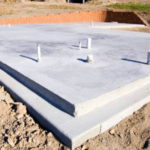 A block foundation is perfect for dry, dense and sandy soil, and it also has many positive qualities. But firstly you need to know how to build a block foundation and different process nuances. Building a reliable house basis will take approximately 10-15% of the home construction total cost. This type of construction will cost even more. Its materials are made at factories and in contrast to self-made concrete, they are always the best quality.
A block foundation is perfect for dry, dense and sandy soil, and it also has many positive qualities. But firstly you need to know how to build a block foundation and different process nuances. Building a reliable house basis will take approximately 10-15% of the home construction total cost. This type of construction will cost even more. Its materials are made at factories and in contrast to self-made concrete, they are always the best quality.
The foundation name speaks for itself. Its components are large assembling or foundation blocks. Such a construction takes much less time than other types – but it needs some additional equipment to lift and move heavy materials.
Preparation
- To build a basement or underground garage. It will be an excellent basis for construction of one-, two- and three-storey houses with a basement or other interesting underground ideas.
- To perform combined building process. Often, to strengthen the construction you need to perform a monolithic belt over blocks consisting of fittings, which are located along walls without any breaks. Fittings are reinforced with concrete solution.
- A great method for the combined construction direction, in which a block is placed on top of a monolithic slab. Such a way makes it possible to build an additional room, garage or basement – perfect solution.
- Foundation design is quite simple in many ways;
- Very high performing speed with any ideas;
- Minimum materials consumption and not huge dimensions;
- Additional savings in construction process;
- Resistance to temperature changes and weather conditions;
- Does not require a large number of workers;
- Necessary materials are made at factories.
Disadvantages include its relatively lower strength, but for the majority of buildings on a safe soil such strength is enough and these facts are not problems. It is not recommended to be built on clay, silt, peat and soft soil due to their low strength and the presence of high level of underground water table. Furthermore, such types of soil in spring and fall periods prone to deformation and subsidence.
List of instruments and materials
To organize this building construction type by your own hands, you need to have available following instruments: a hacksaw, blocks, cement mortar, sand, shovel, waterproofing material, trowel, building level.
The construction of block Foundation
- Preparatory period. At the beginning you should prepare ground under a future construction and delivery all needed materials. Then clear up a plot from debris and make a layout.
- Digging a pit. You need to dig a trench with a depth of about 8-12 inches in the place, where you prefer to lay the future structure. On its bottom play a cushion composed of gravel and sand with water. The cushion top sheet should be slightly below trench edges. You have to make sure that the cushion level over the entire length is approximately identical.
- Installation. Fill earlier pre-kneaded cement on the cushion. It does not serve as fastening all materials, but for possible filling of irregularities between them. Therefore, you should use cement for this purpose. Pull a cord in corners to avoid distortions. With the help of a crane place concrete blocks on a created cushion with concrete, thus thoroughly setting their level. After laying their first level, place rest of materials in compliance with the same principle.
If you prefer to set a foundation on monolithic slabs – firstly, perform filling of monolithic foundation. As soon as this structure is ready, you should lay it on a block top, leaving some room for communications. Such a structure necessarily needs some waterproofing.
It is also possible, after these processes, fill up a floor with concrete that will also give it a kind of monolithic slab. This technology remains identical as the monolithic foundation building. But it is acceptable, where there is no groundwater. This method also gives a basement more significant shrinkage than if it will consist only of blocks. The base load will fall on main materials, and slabs can give motions. To make competent waterproofing in this case – necessary basis walls should be drilled along perimeter by puncher and armature edges should be fixed inside a future slab.
Recommend:
Slab foundation pros and cons.
Raft foundation definition and types.






